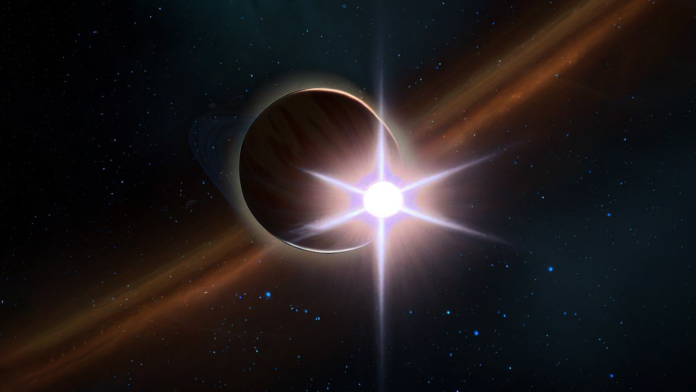In the vast expanse of the cosmos, a peculiar celestial body is challenging our understanding of the universe. This object, known as WD0032-317B, is a brown dwarf that’s hotter than our sun and orbits a distant star at an astonishing speed.
The Brown Dwarf That Defies Expectations
Brown dwarfs, often referred to as “failed stars,” are gaseous bodies that share similarities with Jupiter’s atmospheric composition. They are typically 13 to 80 times larger than Jupiter and begin to fuse hydrogen isotopes in their cores. However, they lack the mass to trigger the self-sustaining stellar fusion that powers stars like our sun.
Most brown dwarfs burn at around 4,000 degrees Fahrenheit, which is relatively cool compared to most stars. However, WD0032-317B, located 1,400 light-years from Earth, is not your typical brown dwarf. Its surface temperature measures a blistering 13,900 degrees Fahrenheit, several thousand degrees hotter than the surface of our sun.
A Celestial Oddity Orbiting at Breakneck Speed
What makes WD0032-317B even more intriguing is its proximity to its host star, an ultra-hot white dwarf. The brown dwarf is so close to its star that it completes an orbit in just 2.3 hours. This proximity results in a tidal lock, with one side of the brown dwarf perpetually facing its star, leading to a significant temperature differential between its day and night sides.
The equilibrium temperature of WD 0032−317 compared to other known systems
The companion of WD 0032−317, a brown dwarf, has an equilibrium temperature that surpasses that of any known giant planet. When we disregard its inherent luminosity and albedo and assume thermal equilibrium with the external radiation, the companion’s ‘equilibrium’ temperature is around 5,100 K. This temperature is about 1,000 K higher than that of KELT-9b, the most heated known exoplanet, and it receives an extreme-ultraviolet flux that is approximately 5,600 times greater.

However, it’s important to note that the companion of the hot white dwarf NN Serpentis has an even higher equilibrium temperature, around 6,000 K. But, with a mass of 0.111 ± 0.004 solar masses, NN Serpentis’s companion is a fully-fledged main-sequence star, not a brown dwarf or an object near the hydrogen-burning limit.
The temperature difference between the day-side and night-side of WD 0032−317’s companion is also significant. Depending on the model used for the white-dwarf core, the temperature of the companion’s heated day-side varies between approximately 7,250 and 9,800 K, which is as hot as an A-type star. The night-side temperature is about 1,300 to 3,000 K. This results in a temperature difference of about 6,000 K, which is about four times larger than that of KELT-9b.
These extreme temperatures and conditions make WD 0032−317 a unique celestial system in our current understanding of the universe.
Here are some Quick Questions and Answers
What is a Brown Dwarf?
A brown dwarf is a celestial object that occupies the space between the largest planets and the smallest stars. They are often referred to as “failed stars” because they share many characteristics with stars, but they lack the mass necessary to ignite the nuclear fusion of hydrogen in their cores, a process that powers stars like our sun.

Why is a Brown Dwarf Different from Other Stars?
Brown dwarfs are different from stars primarily because of their mass and the subsequent inability to sustain hydrogen fusion. While they form much like stars, from the gravitational collapse of gas and dust clouds, their mass is not sufficient to generate the pressure and temperature needed for hydrogen fusion. Instead, they can only fuse deuterium (a heavier isotope of hydrogen) and lithium, if at all. This lack of sustained fusion makes them cooler and less luminous than stars. They also do not have a long-lasting source of energy, so they slowly cool down over time, unlike stars which maintain their brightness for a significant portion of their lifetimes.
When Does a Planet Become a Brown Dwarf?
The distinction between a large gas giant planet like Jupiter and a brown dwarf is not entirely clear and is a topic of ongoing research. However, one commonly used criterion is the ability to fuse deuterium. Objects with a mass below 13 Jupiter masses are classified as planets because they cannot generate the pressure and temperature necessary to fuse deuterium. Conversely, objects with a mass above this threshold are capable of deuterium fusion and are classified as brown dwarfs. It’s important to note that this is a somewhat arbitrary distinction and there is a continuum of objects from planets to brown dwarfs to stars, with different characteristics at each stage.
The Future of WD0032-317B
The extreme conditions on WD0032-317B are causing the molecules in its atmosphere to disintegrate into their component atoms. Over time, the brown dwarf is slowly being evaporated by its host star. This process provides astronomers with a unique opportunity to study how hot stars gradually consume their companions and the conditions required for stars to ignite.
Conclusion
The discovery of WD0032-317B is a testament to the wonders of the universe and the endless possibilities that await us in the realm of space exploration. As we continue to probe the cosmos, we can expect to encounter more celestial oddities that challenge our understanding of the universe and push the boundaries of our knowledge


